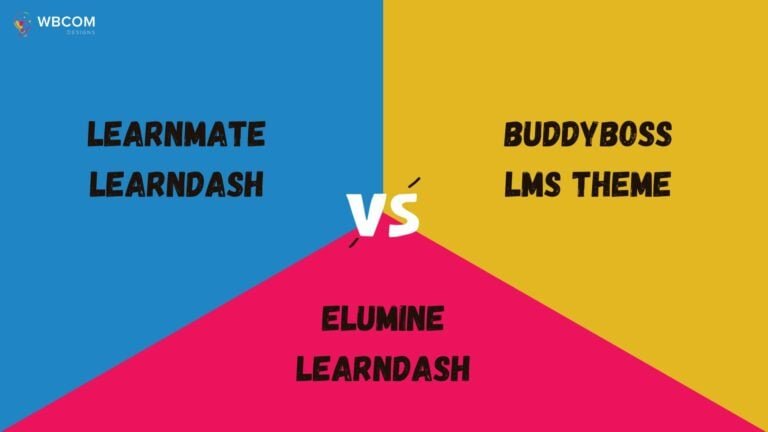Introducing the cornerstone of every developer’s toolkit: the programming font. A crucial component in the realm of coding, the choice of font can significantly impact a developer’s productivity, readability, and overall coding experience. From Fira Code’s elegant ligatures to the clean lines of JetBrains Mono, each font brings its unique blend of clarity, distinction, and customization options to the table.
In this guide, we’ll explore the characteristics and features that define the best programming fonts for developers, empowering coders to find the perfect typographic companion to fuel their coding endeavors.
Table of Contents
ToggleWhat Is Programming Font?
A programming font is a typeface specifically designed for use in writing and reading computer code. These fonts are optimized for displaying text in a monospaced format, where each character occupies the same amount of horizontal space. This uniformity aids in aligning code and maintaining visual consistency, which is crucial for readability and comprehension.
Programming fonts typically feature distinct characteristics tailored to the needs of developers, such as:
1. Clear Distinction between Characters: Programming fonts often differentiate similar characters like ‘l’ (lowercase L), ‘1’ (one), ‘I’ (uppercase i), ‘0’ (zero), and ‘O’ (uppercase o) to minimize confusion.
2. Ligatures: Some programming fonts support ligatures, which are special characters that combine multiple characters into a single glyph. This can improve the readability of certain character combinations, such as ‘!=’ (not equal to), ‘=>’ (arrow), or ‘===’ (strict equality).
3. Consistent Width: Each character in a programming font occupies the same horizontal space, allowing developers to align code vertically and maintain a structured layout.
4. Clarity at Small Sizes: Since developers often work with small font sizes to fit more code on the screen, programming fonts are designed to remain legible even at reduced sizes.
5. Customizability: Many programming fonts offer customization options, such as adjusting font weight, line spacing, or enabling/disabling ligatures, to cater to individual preferences.
What Is A Monospaced Font?
A monospaced font, also known as a fixed-width or non-proportional font, is a typeface in which each character occupies the same amount of horizontal space. This means that every letter, number, and symbol in the font has a consistent width, regardless of its visual complexity. Monospaced fonts are commonly used in coding and programming environments because they facilitate aligning text and maintaining a structured layout, which is essential for the readability and comprehension of code. Additionally, monospaced fonts are often preferred for tasks such as ASCII art and tabular data formatting due to their uniform appearance.
Why Do We Switch To Different Programming Font Options?
Switching to different programming font options can be driven by several factors, including:
1. Readability: Some fonts offer better clarity and distinction between characters, making code easier to read, especially at small font sizes.
2. Personal Preference: Developers may have personal preferences regarding font aesthetics, such as serif vs. sans-serif, or the presence of ligatures, leading them to switch to fonts that align with their tastes.
3. Eye Strain Reduction: Fonts with optimized letter shapes and spacing can reduce eye strain during long coding sessions, improving comfort and focus.
4. Special Features: Certain fonts offer unique features like ligatures, which can enhance code comprehension by visually grouping related symbols or operators.
5. Compatibility: Developers may switch fonts to ensure compatibility across different platforms or code editors, especially if a particular font renders inconsistently or is unsupported.
6. Customization: Fonts with extensive customization options allow developers to tailor the font weight, line spacing, and other parameters to suit their individual preferences and needs.
7. New Releases: Periodically, new programming fonts are introduced with innovative designs or improved readability, prompting developers to explore and switch to these alternatives.
8. Community Recommendations: Recommendations from fellow developers or online communities often influence font choices, as they provide insights into fonts that excel in specific aspects like legibility or aesthetics.
Best Programming Fonts
some popular and widely used programming fonts that were favored for their readability and aesthetics Include:
1. Fira Code

Fira Code is a highly acclaimed programming font known for its exceptional readability and innovative use of ligatures. Developed by Nikita Prokopov, it combines the classic monospaced design with ligatures that enhance the visual representation of code. These ligatures replace sequences of characters with single, more aesthetically pleasing glyphs, improving code comprehension and making certain constructs stand out.
Fira Code’s clean and modern design, along with its extensive customization options, has made it a favorite among developers seeking a typographic solution that balances both functionality and aesthetics in their coding environment.
2. Hack
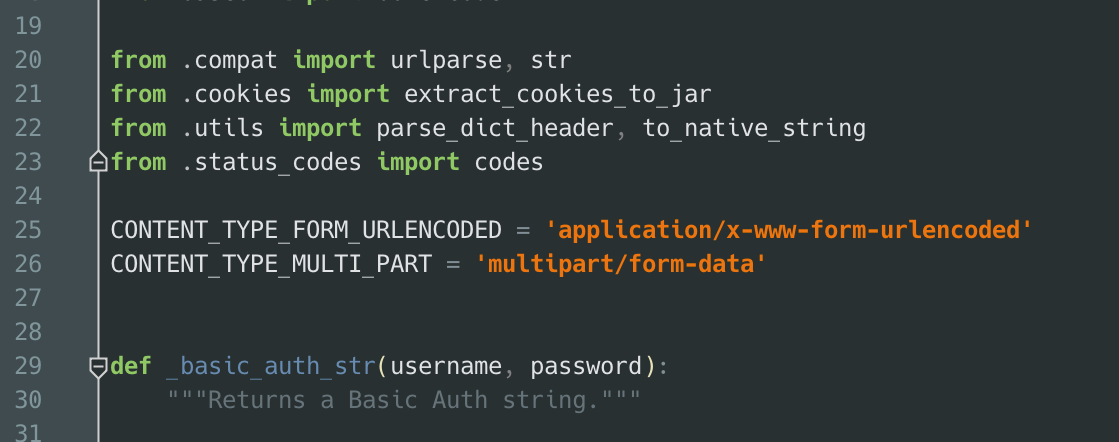
Hack is a widely used programming font renowned for its clean and modern design, making it a popular choice among developers. Developed by Chris Simpkins, Hack is specifically tailored for coding, providing excellent legibility and clarity even at small font sizes. It features a monospaced format, ensuring consistent spacing between characters, which is essential for aligning code properly.
Hack’s distinct characters and subtle design elements contribute to reduced eye strain during long coding sessions, while its open-source nature allows for customization to suit individual preferences. With its combination of readability, functionality, and versatility, Hack continues to be a favored font in the programming community.
3. JetBrains Mono
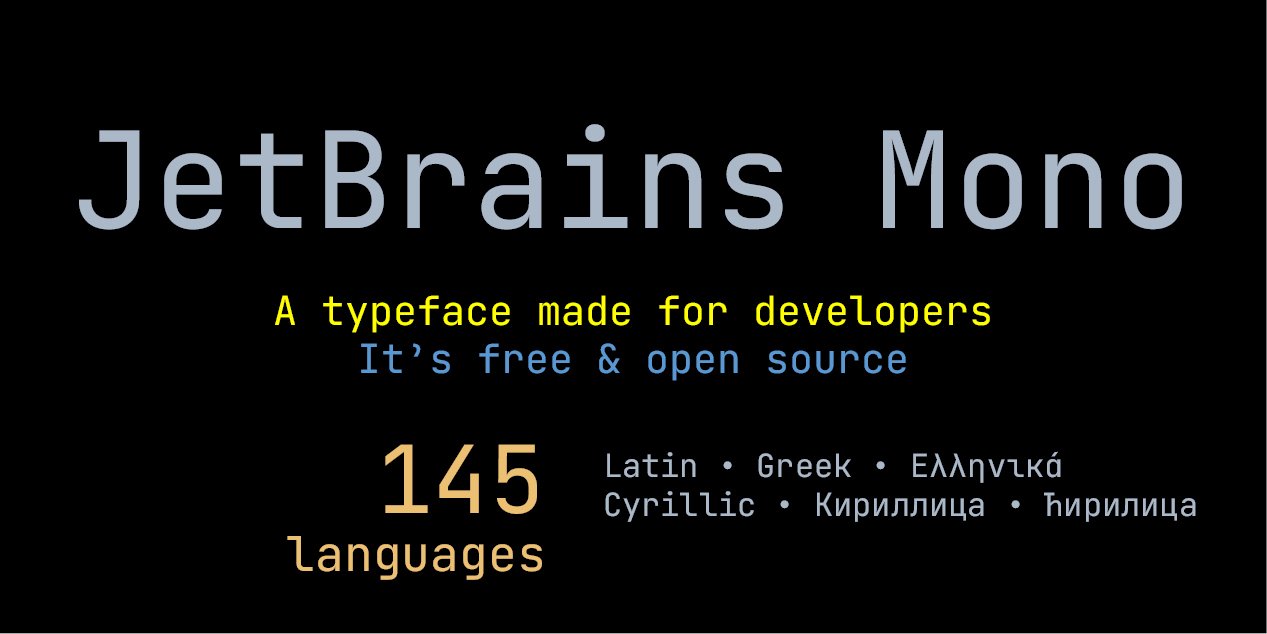
JetBrains Mono is a meticulously crafted programming font designed by JetBrains, renowned for its exceptional readability and developer-centric features. Developed with the needs of coders in mind, JetBrains Mono offers excellent legibility across various coding environments, thanks to its balanced proportions, clear letterforms, and ample spacing.
JetBrains Mono supports ligatures, enhancing the visual representation of code without sacrificing readability. With its thoughtful design and attention to detail, JetBrains Mono has become a go-to choice for developers seeking a comfortable and efficient coding experience.
4. Cascadia Code
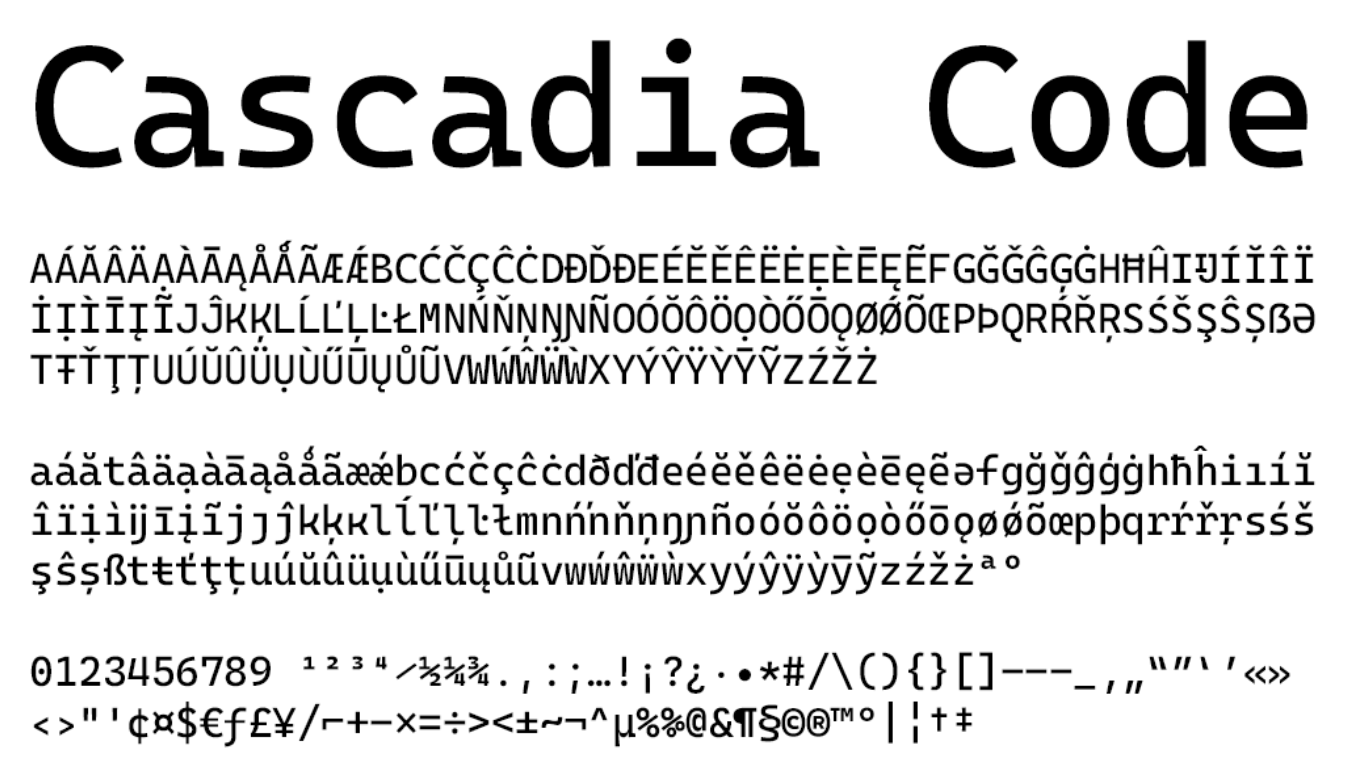
Cascadia Code stands out as a popular programming font developed by Microsoft specifically for its Windows Terminal application. Known for its modern and clean design, Cascadia Code offers excellent readability, making it a preferred choice among developers. One of its notable features is support for ligatures, which enhances the visual appearance of code by replacing certain character combinations with special glyphs. This contributes to improved code comprehension and a more aesthetically pleasing coding experience.
Cascadia Code’s consistent character width and balanced proportions ensure code alignment and readability, even at smaller font sizes. With its focus on clarity, functionality, and compatibility with various coding environments, Cascadia Code continues to gain traction in the programming community.
5. Inconsolata

Inconsolata is a widely acclaimed programming font celebrated for its exceptional clarity and legibility, particularly in smaller font sizes. Developed by Raph Levien, this monospaced font features clean lines and distinct letterforms, making it easy on the eyes during extended coding sessions. Inconsolata’s thoughtful design includes subtle variations in character width, contributing to a balanced and visually pleasing appearance. With its lack of frills and focus on readability, Inconsolata remains a popular choice among developers seeking a reliable and efficient typographic solution for coding environments.
6. IBM Plex Mono
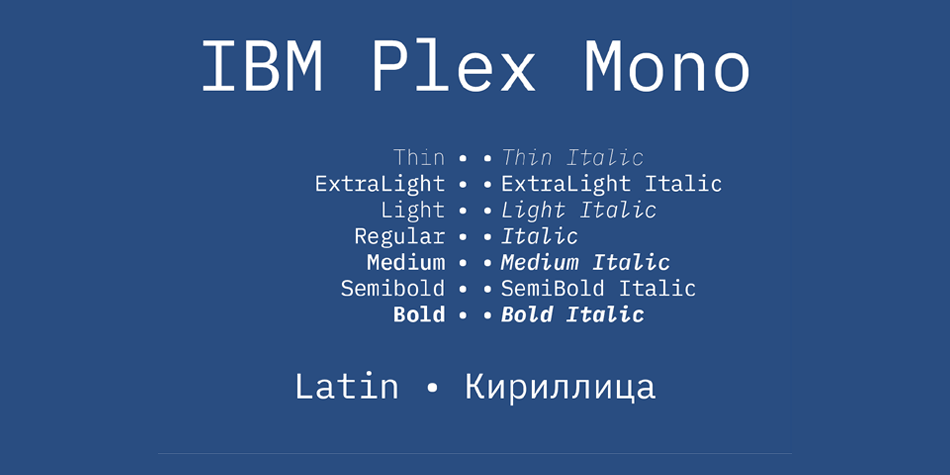
IBM Plex Mono is a versatile monospaced font designed by IBM as part of the Plex font family. Renowned for its clean and modern appearance, Plex Mono is tailored for coding environments, offering excellent readability and clarity. Developed with careful attention to detail, this font features consistent character width and balanced proportions, ensuring uniformity and alignment in code structures.
With its open-source nature, IBM Plex Mono is freely available for developers and supports a wide range of languages and character sets. Its readability, legibility, and compatibility across various platforms make IBM Plex Mono a popular choice among developers seeking a dependable and aesthetically pleasing programming font.
7. Operator Mono
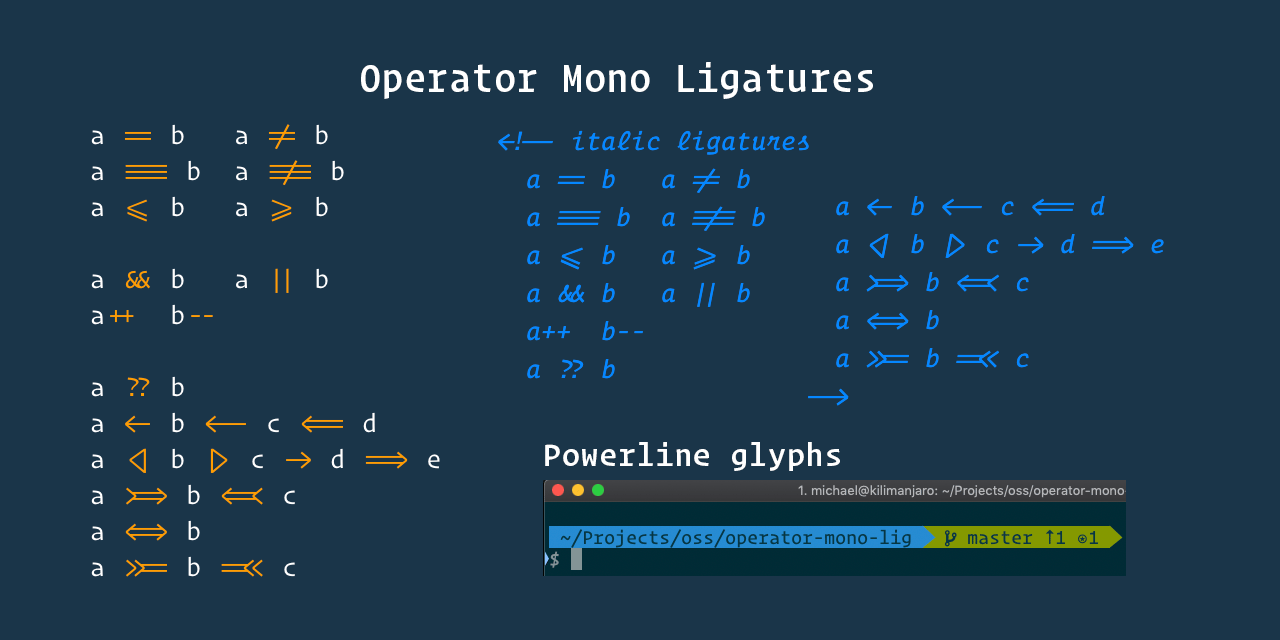
Operator Mono is a distinctive programming font highly regarded for its unique design and aesthetic appeal. Developed by Hoefler & Co., Operator Mono features elegant letterforms with subtle variations in stroke width, giving it a sophisticated and refined appearance.
Its Notable characteristics of Operator Mono include its tall x-height, distinctive letter shapes, and stylish ligatures, which enhance the visual appeal of code while maintaining excellent readability. Although a commercial font, Operator Mono has gained popularity among developers for its distinctive look and the added flair it brings to coding environments.
8. Monoid

Monoid is a popular programming font known for its clean design and excellent readability, making it a favorite among developers. Developed by Andreas Larsen, Monoid features a monospaced format, ensuring consistent spacing between characters for neat code alignment. Its minimalist aesthetic, combined with distinct letterforms and ample spacing, enhances readability, even at smaller font sizes.
Monoid supports ligatures, which replace certain character combinations with unique glyphs, improving code comprehension and visual appeal. With its focus on clarity, simplicity, and functionality, Monoid continues to be a preferred choice for programmers seeking a reliable and aesthetically pleasing font for coding environments.
Which Programming Font Is Best?
Determining the “best” programming font is subjective and can vary based on individual preferences, coding environment, and personal requirements. What works well for one developer may not necessarily be the best choice for another. However, some programming fonts are widely acclaimed for their readability, clarity, and features. Popular choices include Fira Code, JetBrains Mono, Cascadia Code, and Hack, among others. It’s recommended to try out different fonts to see which one suits your needs and preferences best. Ultimately, the “best” programming font is the one that enhances your coding experience and allows you to work comfortably and efficiently.
Final Thought On Best Programming Fonts
Choosing the right programming font is an important decision for developers, as it can significantly impact readability, productivity, and overall coding experience. While there are many excellent options available, it’s essential to consider factors such as readability, aesthetics, and personal preferences when making a choice. Experimenting with different fonts and customizations can help find the perfect fit for your coding environment. Ultimately, the goal is to select a font that not only enhances code readability but also makes coding a more enjoyable and efficient process.
Interesting Reads:
Best WooCommerce Checkout Plugins




